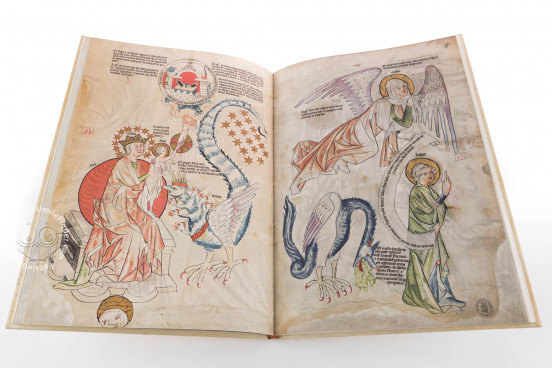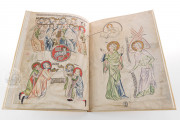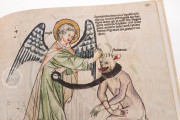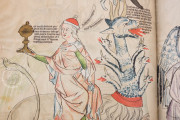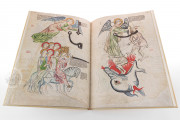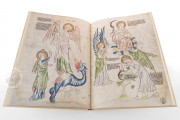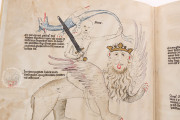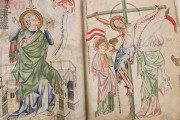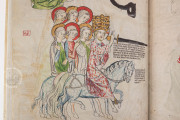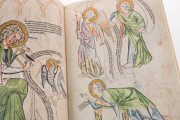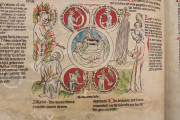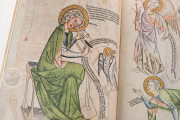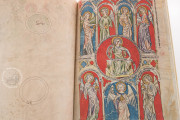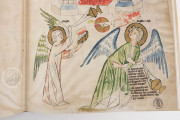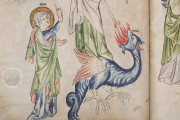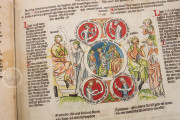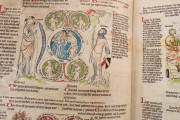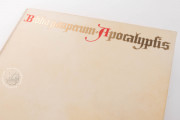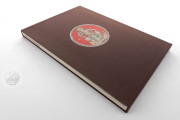The Biblia Pauperum and Picture Apocalypse in Weimar is a Christian picture book created in the fifth decade of the fourteenth century, perhaps at the monastery of Saints Peter and Paul at Erfurt (central Germany). It comprehensively visualizes the Christian understanding of salvation history. The manuscript boasts forty-one very large pages of illustrations in line drawing with washes of color and—in the Apocalypse—gold leaf.
The illustrations in the Biblia pauperum are arranged two per page. The elements of each image are presented consistently, with a New Testament scene (plus the extra-biblical Coronation of the Virgin) in a central roundel surrounded by figures of prophets and Old Testament vignettes.
Two Approaches to Salvation History
Biblia pauperum (literally "Bible of the poor") is a designation for a type of picture book that visualizes the Christian understanding of the typological relationship of events and persons described in the Old Testament as prefiguring or prophesying events in the life of Christ and the Church. The Apocalypse is the final book of the Christian Bible, in which Saint John the Divine describes his vision of events leading to the end of time.
Two Artists
The Weimar manuscript is the work of two artists employing the same technique of line drawing with washes. Both illuminators pay particular attention to the appearance of an entire opening of facing pages.
The illuminator of the Biblia pauperum (fols. 1-10) uses color to connect the four illustrations of each opening. The central scene always has a bright blue background, and the backgrounds for each group of Old Testament prophets (always in roundels two above and two below the central scene) have red or green backgrounds in a consistent pattern. The result is that every opening has a concentration of red at the upper left and lower right and green at the lower left and the upper right, bringing together the four illustrations into a decorative pattern.
Monumental Compositions
The Apocalypse illustrations (fols. 11-22) feature large figures against the bare parchment ground. The artist has carefully arranged the elements to create harmony across facing pages, sometimes presenting events out of biblical sequence to do so.
For example, Christ in the Clouds (Apocalypse 1:7-8) is pictured across from Christ Enthroned with the Book (Apocalypse 4-5), even though the episodes are not contiguous in the text (fols. 12v-13r). The artist has depicted the four living creatures first described in Apocalypse 4 in both illustrations, creating visual harmony across the opening.
Inscriptions in Latin and German
Inscriptions abound in the Weimar manuscript. In the Biblia pauperum, they follow a predictable scheme with a title and verses in Latin at the top and sayings of the prophets inscribed in the roundels in Latin and nearby in Middle High German. Each Old Testament type is explained in Latin and German.
In the Apocalypse there are descriptive labels in Latin, and speech is represented as Latin text on a scroll held by the speaker. The manuscript's texts are all the work of a single scribe writing Gothic Textualis, and the illustrations are numbered consecutively through both sections.
A Prize for the Grand Dukes of Saxe-Weimar-Einsenach
The manuscript was in the monastic library at Saints Peter and Paul, Erfurt, at the dissolution of the Prussian monasteries in 1803. In 1809, Christian August Vulpius (1762-1827) acquired it for the library of the grand dukes of Saxe-Weimar-Eisenach. After the abdication of the grand duke in 1918, the library was renamed the Thüringische Landesbibliothek, which—after administrative changes and the reunification of Germany in 1991—became the Herzogin Anna Amalia Bibliothek.
We have 2 facsimiles of the manuscript "Biblia Pauperum and Picture Apocalypse":
- Biblia pauperum, Apocalypsis: die Weimarer Handschrift facsimile edition published by Insel Verlag, 1977
- Biblia pauperum, Apocalypsis: die Weimarer Handschrift facsimile edition published by Edition Leipzig, 2007


